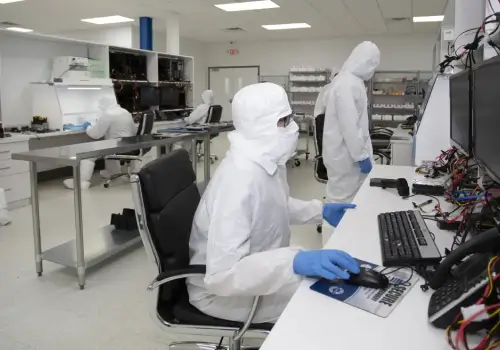
Understanding the Cost of Data Recovery Services
The most common question that we receive is: How much does data recovery cost? The truth is: It depends. Professional data recovery services typically range from $100 to $300 per hour. However, many factors contribute to recovery costs, and every case is unique. Failure types differ between storage devices and require certain expertise and equipment to restore lost data. We have delivered the most comprehensive, transparent services and pricing since 2007. Complete with free diagnostics and a No Data, No Recovery Fee guarantee.
Breaking Down Recovery Costs by Device and Failure Type
While the cost of data recovery varies, some figures can provide a fair overview of pricing. We pulled a sample of cases for the most popular storage devices and compiled the details across several categories. The analysis includes the average recovery times for logical and physical failures on solid-state drives (SSDs), hard disk drives (HDDs), mobile devices, and removable media. It also contains a breakdown of the failure modes seen on each device.
Here are the results.
| Avg. Recovery Time (Hours) | Percentage of Total Cases | |
|---|---|---|
| Storage Device | Software Issues / Physical Damage | Software Issues / Physical Damage |
| SSD | 4.1 / 7.4 | 39.38% / 60.62% |
| HDD | 3.4 / 5.7 | 18.03% / 81.97% |
| Phone | 2.7 / 9.4 | 46.59% / 53.41% |
| Removable Media | 2.7 / 7.1 | 18.49% / 81.51% |
| Avg. Recovery Time (Hours) | Percentage of Total Cases | |||
|---|---|---|---|---|
| Storage Device | Software Issues | Physical Damage | Software Issues | Physical Damage |
| SSD | 4.1 | 7.4 | 39.38% | 60.62% |
| HDD | 3.4 | 5.7 | 18.03% | 81.97% |
| Phone | 2.7 | 9.4 | 46.59% | 53.41% |
| Removable Media | 2.7 | 7.1 | 18.49% | 81.51% |
SSD Data Recovery
SSD data recovery took about 4 hours for drives with software issues and around 7 hours for those with physical damage. Almost 61% of the SSDs in our sample featured physical damage that led to failure. Under 40% of devices failed because of software errors.
Solid-state drives store data in memory cells on complex circuit boards. Retrieving data from flash storage demands specialized hardware, software, and skills.
Hard Drive Recovery
The average hard drive recovery service lasted over 3 hours for software errors. It was just short of 6 hours for physical issues. Nearly 82% of disks in the sample had physical damage while about 18% failed due to logical issues.
Hard drives store data on magnetic platters through electrical processes and mechanical parts. Their compact, moving parts are susceptible to severe damage and wear and tear. Common failures include broken read/write heads, damaged platters, and seized motors. These repairs require a certified cleanroom to prevent further media damage and data loss.
Phone Data Recovery
On average, phone data recovery took less than 3 hours for devices with software errors. In comparison, dealing with damaged devices took about 9 hours. There was a fairly even split between cases with hardware and software issues in our sample.
The NAND storage on the logic board of a smartphone or tablet can fail for numerous reasons. Each situation has unique solutions of varying difficulty.
Removable Media Recovery
The time investment to recover data on removable media like flash drives and memory cards differs. It depends on the specific failure. The average case for software issues took around 3 hours. It was about 7 hours for those with physical damage due to their small, intricate components. Over 81% of the sample involved a damaged USB drive or media card compared to less than 19% for software conflicts.
Like other flash memory devices, these cases typically demand purpose-built tools to reverse data loss.
Determining Data Recovery Costs
When choosing a provider, it is important to choose one that is transparent about how they determine data recovery costs. They should base the price of data recovery services on the condition of the storage device and the scope of work required to successfully restore your data. In essence, the service should depend on the time and difficulty of recovering the data. That is it.
With Secure Data Recovery Services, every case begins with a free diagnostic. This evaluation is done in one of our secure, audited labs and performed by experienced engineers. Each engineer has a unique skill set. They specialize in your exact device type and failure mode.
Once we receive the device and run diagnostics, our team provides a detailed report and a risk-free quote. The report reveals how much of the data is recoverable and the work involved.
Our quotes are precise. Your data recovery costs will never increase for the outlined work. Even if it becomes more difficult than originally expected. The quote is payable upon successful completion and backed by our No Data, No Recovery Fee guarantee.
Do’s and Don’ts That Can Impact Cost
First, shut down the damaged or defective device.
Powering down the device can limit physical damage or prevent it from overwriting deleted data. For best results, shut down once you notice data loss or warning signs, such as hard drive clicking and beeping.
In addition, your first attempt is the best chance for a successful recovery. DIY solutions can often make the problems even worse. Consult an expert if your data is irreplaceable.
The following tips can also improve outcomes and reduce recovery costs:
- Do not run data recovery software on a storage device with physical damage.
- Do not save recovered files to the source drive when using software.
- Do not restore the desktop or laptop to a previous point if unable to boot.
- Do not run commands like CHKDSK or fsck. They can cause permanent damage to the file system and corrupt data.
Call a data recovery professional for a free pricing consultation
800-388-1266Data Recovery Cost Variables Explained
Search the internet for data recovery pricing, and you will find costs ranging from hundreds to thousands of dollars. The truth is that no one can determine the cost without considering all of the variables involved.
For example, let’s assume we have two identical drives with data loss. However, one device was sitting at the bottom of the ocean for a week, and the other wasn't. The process to recover data from each device will be very different. The device with corrosion will be much more difficult, time-consuming, and need particular expertise.
In the absence of specific details for your case, prices are simply guesses. These estimates say very little about how much you will spend to restore your data to a usable condition.
Flat and per-gigabyte rates are the least effective measures for achieving fair, honest pricing. The volume of data makes no difference in the scenario above, so the cost should not change.
Below, we list a few of the variables that impact pricing:
Time Investment
Data recovery engineers spend years gaining the technical expertise and experience required to achieve the best outcomes. The more experienced they are, the better their results. Professional services can cost $100 to $300 per hour, depending on the difficulty associated with the process.
Our experts hold the most credentials in the industry, allowing us to achieve a 96% success rate. If, for any reason, we can’t successfully recover your data, you pay nothing. It’s that simple. No recovery? No fee.

Advanced Facilities and Tools
Our technicians use a wide range of tools and specialized equipment for both non-invasive and invasive data recovery. These might include software utilities for locating and extracting lost data or specialized hardware, such as head combs or drive spindle replacement tools.
Complex cases often demand proprietary, forensic-grade tools that allow manual access and retrieval. These projects require certified Class 10 ISO 4 cleanrooms, soldering stations, and specialized software and hardware. That is a sign of a service that can achieve the best results and fastest turnarounds.
Audited labs cost hundreds of thousands of dollars to build and maintain. Our state-of-the-art facilities can resolve any data loss scenario, regardless of device or failure.
Library of Donor Parts
When it comes to providing quick turnarounds, immediate access to storage device parts is vital. You must match each component using several identifiers. These range from the manufacturer and model to the specific firmware or the date of manufacturing. Data recovery companies collect and classify hundreds of replacement parts for various storage devices, including hard drives, solid-state drives (SSDs), phones, and others.
Moreover, we must repair any failed device to a functional state to enable file-level recovery. For this reason, having access to a library of components is essential. These components include read/write heads, controllers, microchips, and much more. Our ability to provide our customers with the highest success rates in the industry relies on this huge collection.
We maintain partnerships with major device manufacturers. These partnerships give us the inside edge for complex data loss scenarios without threatening existing product warranties. They also allow us to keep pace with rapid progress, allowing us to respond to current and emerging data loss threats.
Audited Infrastructure
Providers must have commercial space and the necessary physical and cybersecurity mechanisms to handle customer data safely. Physical security includes in-person monitoring, alarm systems, and interior/exterior surveillance.
Security is at the heart of data recovery services. In addition to all physical security precautions, our labs undergo regular third-party audits to ensure that all data handling procedures are certified.
Secure Data Recovery Services undergoes voluntary third-party SSAE 18 SOC 1, 2, and 3 audits to verify the effectiveness of over 80 cybersecurity protocols. We routinely help customers recover highly sensitive and confidential information, keeping that data safe at every stage.
The infrastructure controls we employ have a high cost. However, they are essential to providing our customers with the confidence that their data is kept secure and confidential throughout the process.
Research and Development
Creating new tools and utilities is important for keeping up with existing failures and the evolution of storage technologies. Manufacturers are constantly discovering more effective ways to store data. At the same time, data recovery firms face the challenge of adopting new solutions to the increasingly complex ways data can become corrupted or lost. For this reason, we invest heavily in R&D.
Data recovery is not always possible with available tools. Every data loss case is unique. Often, the techniques required to resolve specific data loss scenarios don't exist, so new techniques need to be created. We have dedicated research and development teams for every media type. We are able to help where others fall short.
Why Choose Secure Data Recovery?
We strive to ensure that every aspect of our business operations, including customer service, pricing, and data recovery procedures, are performed honestly and transparently. And we provide proof. The results of our third-party cybersecurity audits and certifications are available to customers on our website. In addition, our data recovery engineers maintain a documented 96% success rate, which is the highest in the industry.
We use the same tools and security practices to successfully restore data for all of our customers. That includes government agencies, the military, multinational corporations, small and medium-sized businesses, and individuals.

These are some of the benefits of choosing professional data recovery services.
We know that cost matters, and we work hard to give our customers the best value for their money. That’s why we stand by our No Data, No Recovery Fee guarantee. If, for any reason, we can’t get your data back, you pay nothing.
Call us at 800-388-1266 to speak to a data recovery specialist and take the first step toward recovering your data.
